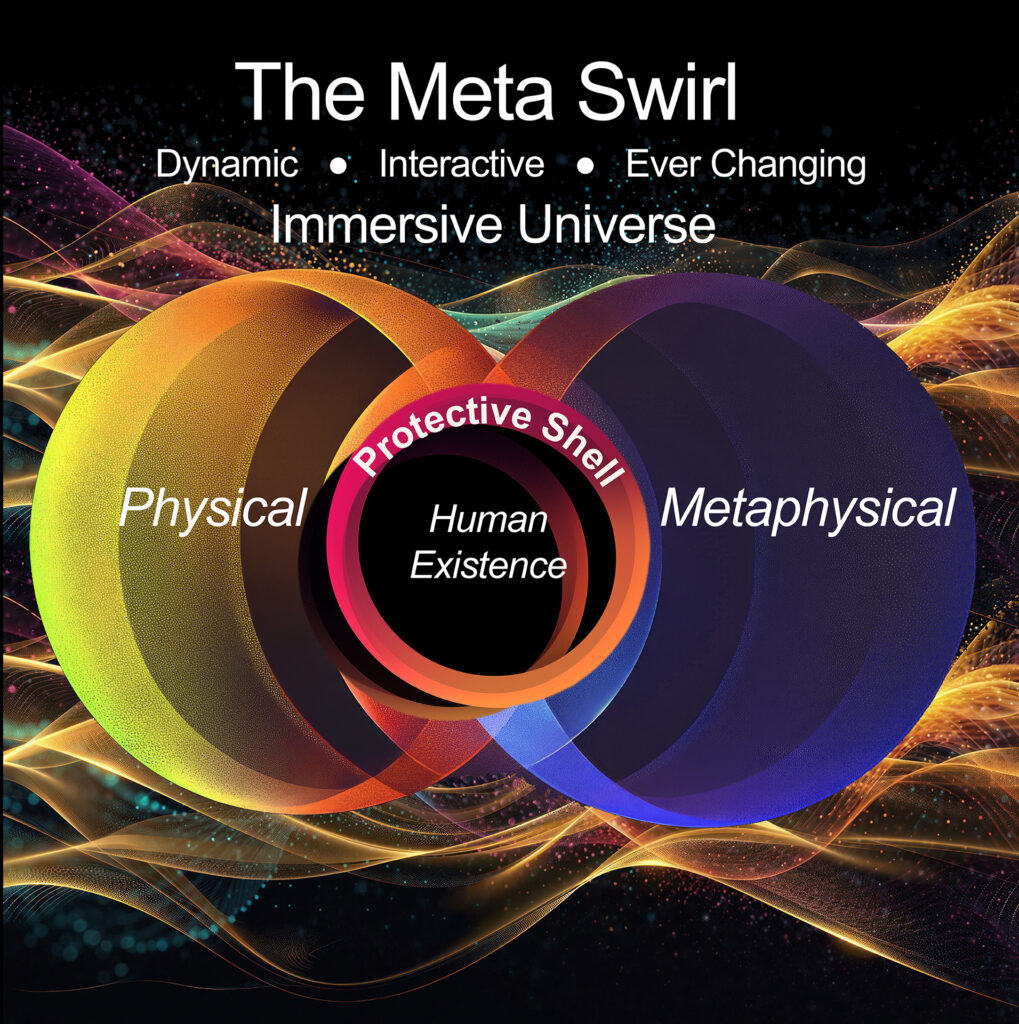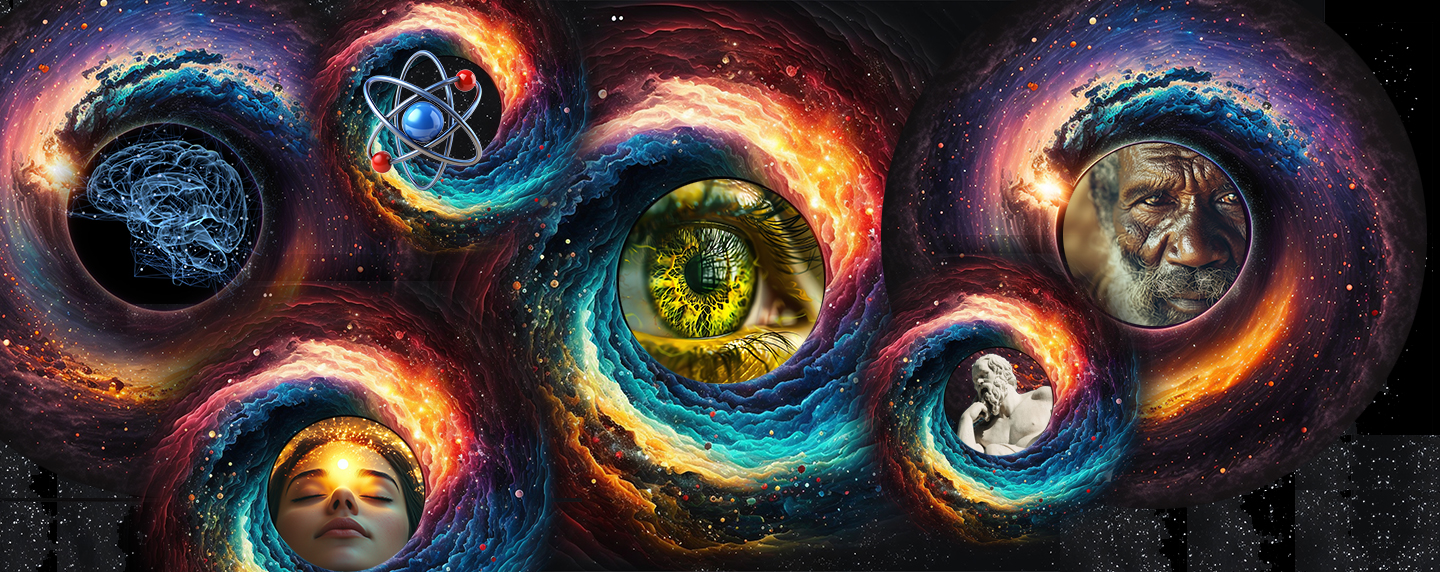I’ve cast my investigatory net far and wide, from the esoteric to the latest scientific findings, to uncover answers to questions like these for myself. In the process, I’ve had an opportunity to consider how people look for answers, where they look, and how they may or may not connect the dots.
I’ve found, first and foremost, that any worthwhile approach requires a thoughtful examination of one’s life journey, experiences, and aspirations. Superficial answers can never satisfy the questioner’s deep existential needs, nor do they lead to anything very helpful in achieving everyday goals either.
I’ve also found, however, that most attempts to answer big-picture questions emerge from within the context of the cultural, spiritual, philosophical, and scientific filters of the person searching. That’s fine to a certain extent, but I liken this to going through life like a racehorse with blinders on its eyes.
In other words, in the effort to stay focused on what’s immediately in front of us, we tend to restrict our search to within the narrow framework of what’s familiar—within the frame of what we know or think we know to be true.
What If We Took Off Our Blinders?
What if we took the blinders off and looked outside the frame, beyond that which is familiar? What if getting out of our lanes would lead to new insights about the answers we hope to find? What if we could see things from someone else’s point of view? What if we could break through the constraints of our cultural and religious upbringing and look at the question from outside ourselves?
I used to ask similar types of questions in my earlier life when I worked in business, specializing in change management. My various jobs in those days revolved around helping organizations redesign their business and manufacturing processes to better compete within their changing business environments.
I learned then that the starting point for finding answers to perplexing business problems was to help team members remove their blinders so they could see beyond the old way of doing things toward the cloud of possibilities where potential answers to their problems could emerge.
I’m learning the same thing again as I search for answers to matters of a higher-order nature. The only way to find meaningful answers to the big-picture questions about life is to remove our blinders so that we can see beyond the constraints of the filters that keep us in our lanes.
Taking off our blinders helps us broaden our focus and think big.
The Meta Swirl Framework Helps Us Focus
The flip side of broadening your perspective and thinking big is that you might get disoriented in that cloud of infinite possibilities. Such an outcome would be no better than getting lost down a rabbit hole in pursuit of some extraneous element of your search.
I know this because I’ve felt disoriented many a time throughout my search. Hot on the tracks of pursuing a path to some truth, I would realize I had gotten myself lost. I had either fallen into the cracks of too many details or had gotten overwhelmed by the big picture. I often found myself wondering what I was doing and where my search for the answers to life’s big questions was taking me.
Was I still on the hunt to find out if there was such a thing as a God, or was I getting lost in the history of the Roman Empire at the time of Christ? Was I still looking to discern if I was equal parts spiritual and physical, or had I gone too far down a path of an esoteric point of view that had some, but not all, answers? Was I connecting the dots across the world’s belief systems in order to see the larger truth reflected in all of them, or had I gotten fixated on one of those over another?
I sometimes felt as if I was caught up in a swirl, gyrating, whirling around issues, but not being able to pinpoint specific answers to my questions.
It was out of that sense of feeling off balance that I developed the framework of a Meta Swirl, which helps me to see things in the context of the larger reality, wherein all answers reside. At the same time, it helps me return my thoughts to ground zero when I feel I’m getting lost in the clouds.
Both the Big and Small Pictures Have Merit
The Meta Swirl framework helps me realize that both the big picture and the small picture have merit and that there’s no way to escape the fact that we are all perpetually bound up in this swirl of reality, where everything affects everything, big and small, all at the same time.
Essentially, the Meta Swirl framework provides a perspective for considering the richness and complexity of the human experience within the context of an ever-changing universal reality. It does this by helping us acknowledge that everything we think, believe in, and act upon happens within a reality that’s immersive and interactive—one that we influence, just as it influences us.
At the same time, the Meta Swirl points to some fundamental areas of knowledge, which help to shed light on the various fragments of reality that encase our everyday lives. These fragments, explored by scientists, spiritual leaders, academicians, and others who have in-depth knowledge within their fields of expertise, are all aspects of the framework that I’ll talk about in the next article.
The Broad Perspective
Let’s look first at the larger context of reality, which provides the vessel, so to speak, where the dance of our lives unfolds.
An Immersive Universe
Starting with the broadest possible lens we can use, the Meta Swirl paints the idea of a dynamic and immersive universe within which everything connects to everything and where everything contributes to the ongoing interplay within it. A key aspect of it is that we’re not separate from it, watching what happens as if viewing a movie. It’s more like we’re actively engaged in an interactive play. What happens in the play affects our responses, which, in turn, affects where the designated actors take the play.
Interconnected Realms
There are at least two realms or dimensions within the universe. The idea that there are many more is a matter of scientific interest but has not yet been proven. So, to avoid getting too bogged down in that particular speculation, let’s stick with the idea that there are two that most people would say exist—the physical and the metaphysical.
The physical contains everything that we can measure using current scientific instruments. It’s the realm of the tangible and the observable. The metaphysical includes experiences and phenomena that lack concrete forms, such as spiritual experiences, intuitions, and near-death encounters. This realm is more difficult to measure than the physical but immensely impacts our perception and behavior.
Dynamic Effects
Neither of these two realms is static. Both realms are in constant flux, evolving and influencing each other, constantly morphing into something beyond what they had once been. Their dynamic nature means that even our understanding of them is continually expanding.
And neither of them exists as an island unto itself. They overlap. What happens in one realm can lead to effects in the other. For example, a profound spiritual experience (metaphysical) can alter our day-to-day actions and worldview (physical).
The Closer-In Perspective
Let’s turn now to what’s closer to home, to our everyday lives, and to the types of things we feel have a more direct and immediate bearing on our lives.
Human Existence
One could argue with the idea that we have a body by suggesting that reality is all an illusion. However, for all practical purposes, we see ourselves as living within a physical realm, and most people would agree that our physical and cognitive abilities, together with our sense organs, are fine-tuned to help us live as physical beings.
On the other hand, it’s hard to disagree that we also have a side that we can’t explain—a side we can’t see due to the fact that our senses tune it out. It’s the side that pours over into another realm that pulls us toward the spiritual, where premonitions come from, where sudden insights emerge, and so on.
Recognizing this, the Meta Swirl places humans somewhere in the overlap of the physical and metaphysical realms and suggests we are influenced by and contribute to both. It’s in these overlapping realms where our dance of life plays out—where the physical parts seem apparent and where the metaphysical seem questionable and mysterious to our logical selves.
Our Shells
A major factor contributing to the way we survive in our human forms has to do with our five senses. They’re similar to the shells that clams build to protect themselves from predators in their watery environments, only far more elaborate.

Our shells consist of layers upon layers of defenses, starting with our five basic senses—sight, sound, taste, touch, and smell. Like a clam, these five senses form a protective layer that keeps us focused on our physical survival. But, unlike clams, our defenses extend well beyond these into the emotional, cultural, philosophical, religious, scientific, and psychological aspects of our lives.
Our cultural defenses, for instance, as well as religious beliefs that align with our cultures, keep us focused on maintaining the security of the “tribe” we belong to and keeping us safe from any would-be predators who may think and act differently from ourselves.
In Summary
So far, I’ve suggested that the Meta Swirl is a framework for understanding our human experience within the context of the larger universal reality of which we are a part. It serves as a shorthand reference for all aspects of an interconnected, dynamic, evolving, and immersive universe.
The Meta Swirl framework proposes that reality, or our perception of it, is not a singular, static phenomenon but a multifaceted, ever-changing process, wherein humans shape their reality through the dynamic interplay of experiences, perceptions, and thoughts, spanning both the physical and metaphysical realms.
What all of this has to do with our everyday lives is the focus of the next article in this series.
Continue to the Next Article
The next article takes the Meta Swirl down to a level that more directly affects our everyday lives. It expands on the idea that we live within a Meta Swirl of reality, but it shifts the perspective to the much more actionable level of the here and now.
Click here to continue to The Meta Swirl: A Framework for Reflecting on the Human Experience.




